Hungry for something warm, comforting, and utterly delicious? Dive into the world of Japanese soups, where each bowl is a hug in liquid form, perfect for any season. From the light and refreshing to the rich and hearty, we’ve rounded up 19 must-try recipes that’ll bring the exquisite flavors of Japan right to your North American kitchen. Ready to slurp your way through these delights? Let’s get cooking!
Miso Soup with Tofu and Wakame
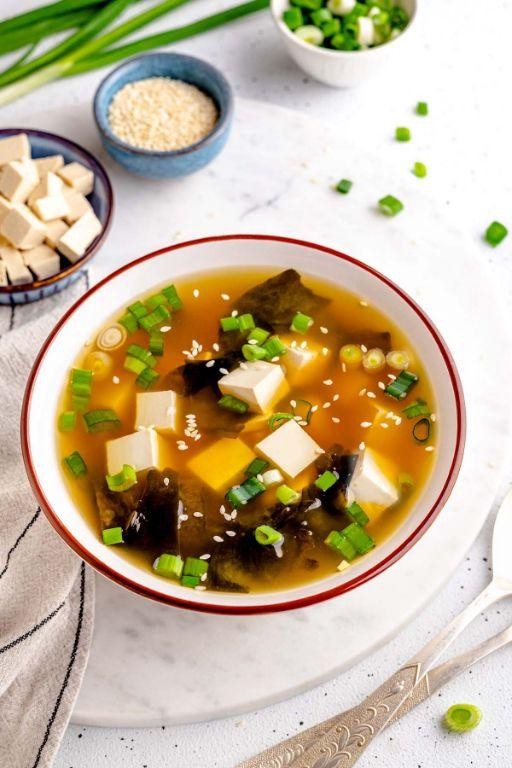
Unlock the simplicity of Japanese comfort food with this easy miso soup recipe. Perfect for a quick lunch or a light dinner, it’s packed with umami flavors and ready in minutes.
Ingredients
- 4 cups water
- 1/4 cup miso paste (white or yellow for milder flavor)
- 1/2 cup silken tofu, cubed (firm tofu works too)
- 2 tbsp dried wakame (rehydrates in the soup)
- 2 green onions, thinly sliced (for garnish)
Instructions
- Heat 4 cups of water in a pot over medium heat until it simmers, about 5 minutes.
- Add 1/4 cup miso paste to the simmering water. Whisk until fully dissolved, about 1 minute. Tip: Avoid boiling to preserve miso’s delicate flavors.
- Gently stir in 1/2 cup cubed tofu and 2 tbsp dried wakame. Simmer for 3 minutes. Tip: Stir gently to keep tofu intact.
- Remove from heat. Let sit for 1 minute to allow wakame to fully rehydrate.
- Ladle into bowls. Garnish with sliced green onions. Tip: Serve immediately for the best texture.
Combining creamy tofu with the sea-like freshness of wakame, this soup offers a comforting balance. Try adding a sprinkle of sesame seeds for extra crunch.
Tonjiru (Pork and Vegetable Miso Soup)
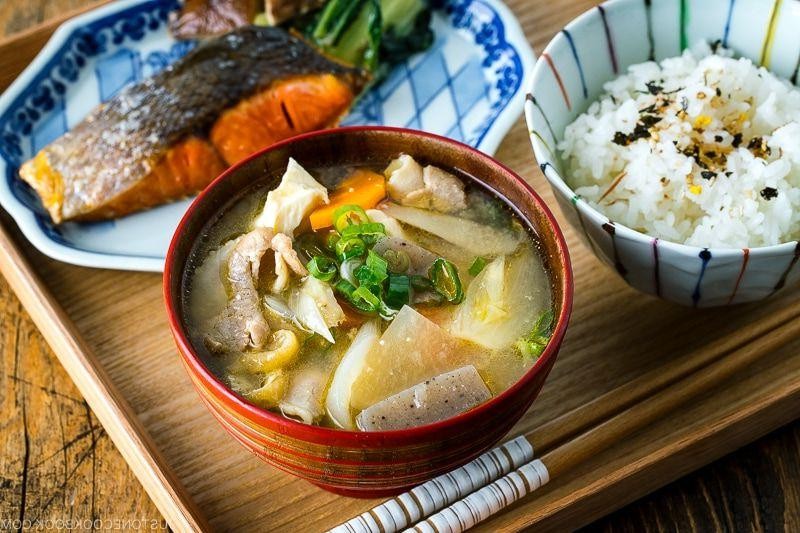
Craving a hearty, flavorful soup that’s both comforting and easy to make? Tonjiru, a pork and vegetable miso soup, is your go-to dish for a satisfying meal.
Ingredients
- 1/2 lb pork belly, thinly sliced (or substitute with pork shoulder)
- 4 cups dashi stock (or water with dashi powder)
- 2 tbsp miso paste (adjust to taste)
- 1 carrot, julienned
- 1 daikon radish, thinly sliced
- 1 potato, diced
- 1/2 cup burdock root, sliced (optional for extra crunch)
- 2 green onions, chopped (for garnish)
Instructions
- In a large pot, brown the pork belly over medium heat until no longer pink, about 5 minutes. Tip: Render the fat for extra flavor.
- Add the carrot, daikon, potato, and burdock root to the pot. Stir-fry for 2 minutes to slightly soften.
- Pour in the dashi stock and bring to a boil. Reduce heat to low and simmer for 15 minutes, or until vegetables are tender. Tip: Skim off any foam for a clearer broth.
- Dissolve the miso paste in a small amount of broth before adding it back to the pot. Simmer for another 5 minutes. Tip: Avoid boiling after adding miso to preserve its flavor.
- Garnish with green onions before serving.
You’ll love the rich umami flavor and the tender chunks of pork and vegetables in every spoonful. Serve with a side of steamed rice for a complete meal.
Sumashijiru (Clear Soup with Seafood)
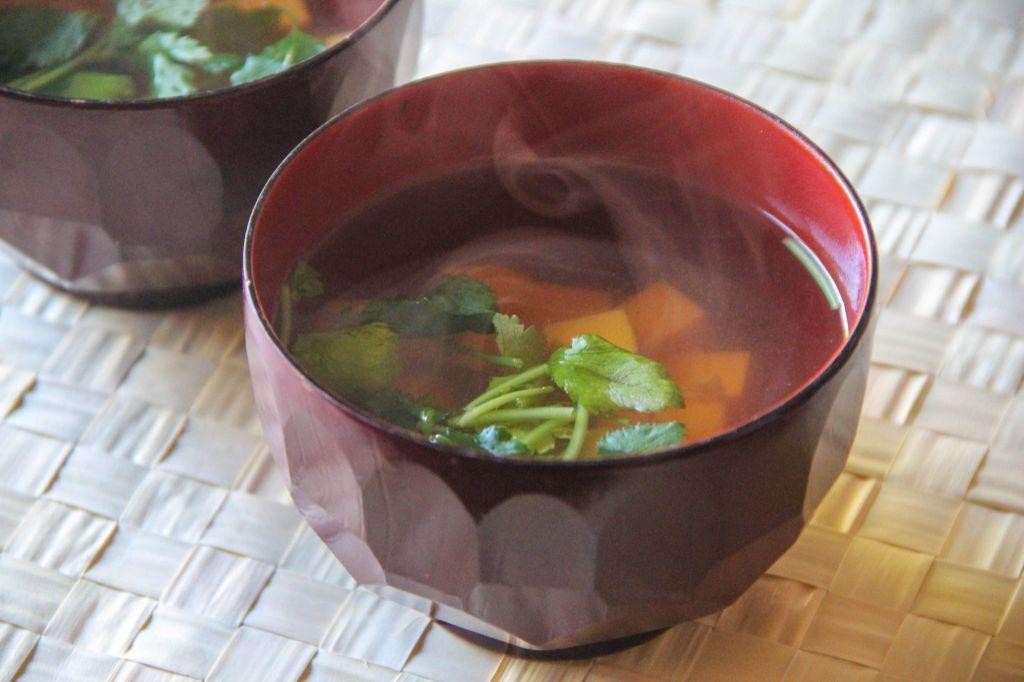
Let’s dive into making Sumashijiru, a delicate clear soup that highlights the freshness of seafood with a clean, umami-rich broth.
Ingredients
- 4 cups dashi stock (homemade or instant, for depth of flavor)
- 1/2 lb mixed seafood (shrimp, scallops, white fish, adjust types based on preference)
- 1 tbsp soy sauce (use light soy sauce for a clearer broth)
- 1 tsp salt (adjust to taste)
- 1/2 cup sliced shiitake mushrooms (fresh or rehydrated, stems removed)
- 2 green onions, thinly sliced (for garnish)
Instructions
- Heat the dashi stock in a medium pot over medium heat until it reaches a gentle simmer, about 5 minutes.
- Add the mixed seafood to the pot, ensuring pieces are evenly distributed. Cook for 3-4 minutes until seafood is just opaque.
- Stir in the soy sauce and salt, tasting the broth to adjust seasoning if necessary.
- Add the shiitake mushrooms to the pot and simmer for another 2 minutes until they are tender.
- Remove the pot from heat and sprinkle with green onions before serving.
Clear and light, this soup offers a subtle sweetness from the seafood balanced by the earthy mushrooms. Serve it as a starter to cleanse the palate or alongside steamed rice for a simple, satisfying meal.
Kenchinjiru (Vegetarian Japanese Soup)
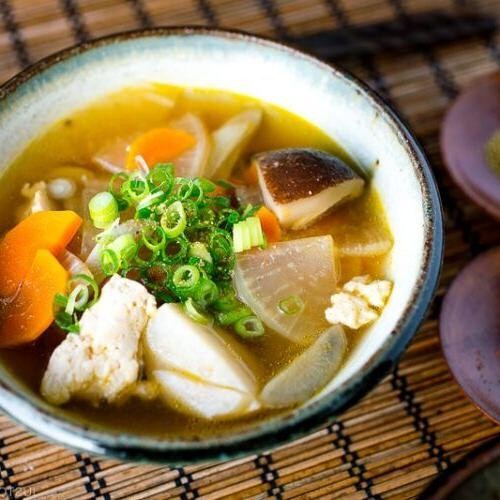
Looking for a hearty, umami-packed soup that’s both comforting and light? Kenchinjiru, a traditional Japanese vegetarian soup, combines root vegetables and tofu in a savory dashi broth.
Ingredients
- 4 cups dashi stock (or vegetable stock for a quicker version)
- 1 tbsp sesame oil (or any neutral oil)
- 1 carrot, sliced into thin rounds
- 1 burdock root, julienned (soak in water to prevent browning)
- 1/2 block firm tofu, pressed and cubed
- 1 tbsp soy sauce (adjust to taste)
- 1 tsp salt
- 1/2 cup shiitake mushrooms, sliced
- 1 cup daikon radish, cubed
- 2 green onions, thinly sliced
Instructions
- Heat sesame oil in a large pot over medium heat until shimmering.
- Add carrot, burdock root, and daikon radish. Sauté for 5 minutes until slightly softened.
- Pour in dashi stock, bringing to a boil. Reduce heat to simmer for 10 minutes.
- Add tofu and shiitake mushrooms. Simmer for another 5 minutes.
- Season with soy sauce and salt. Stir gently to combine.
- Garnish with green onions before serving.
The soup boasts a clear, flavorful broth with tender vegetables and soft tofu. Serve it with a side of steamed rice for a complete meal.
Butajiru (Pork Miso Soup)
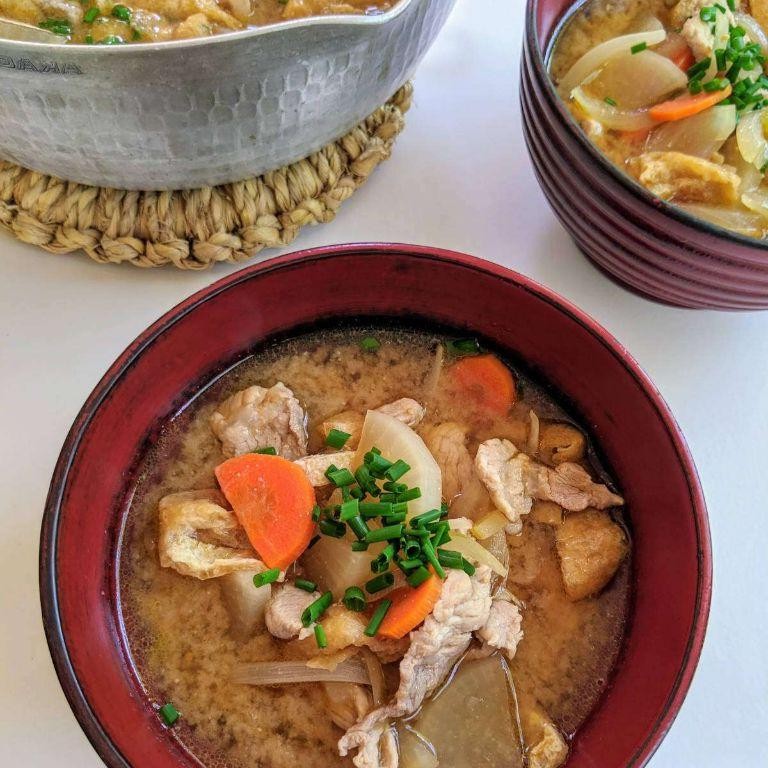
Dive into the heartwarming flavors of Butajiru, a robust pork miso soup that’s both nourishing and deeply satisfying. Perfect for chilly evenings or when you need a quick, flavorful meal.
Ingredients
- 1 tbsp sesame oil (or any neutral oil)
- 1/2 lb pork belly, thinly sliced
- 1 large potato, diced
- 1 carrot, sliced
- 1/2 cup daikon radish, cubed
- 4 cups dashi stock (or water as a substitute)
- 3 tbsp miso paste (adjust to taste)
- 2 green onions, chopped
Instructions
- Heat sesame oil in a large pot over medium heat until shimmering.
- Add pork belly slices, cooking until lightly browned, about 3 minutes per side.
- Stir in potato, carrot, and daikon, sautéing for 2 minutes to slightly soften.
- Pour in dashi stock, bringing to a boil before reducing to a simmer for 15 minutes, or until vegetables are tender.
- Dissolve miso paste in a small amount of broth before stirring back into the pot to avoid clumping.
- Simmer for an additional 5 minutes, ensuring not to boil to preserve miso’s flavor.
- Garnish with green onions just before serving.
Serve this comforting soup piping hot, with the pork belly’s richness perfectly balanced by the miso’s umami depth. For an extra kick, a sprinkle of shichimi togarashi adds a delightful heat.
Osuimono (Clear Broth with Mushrooms)
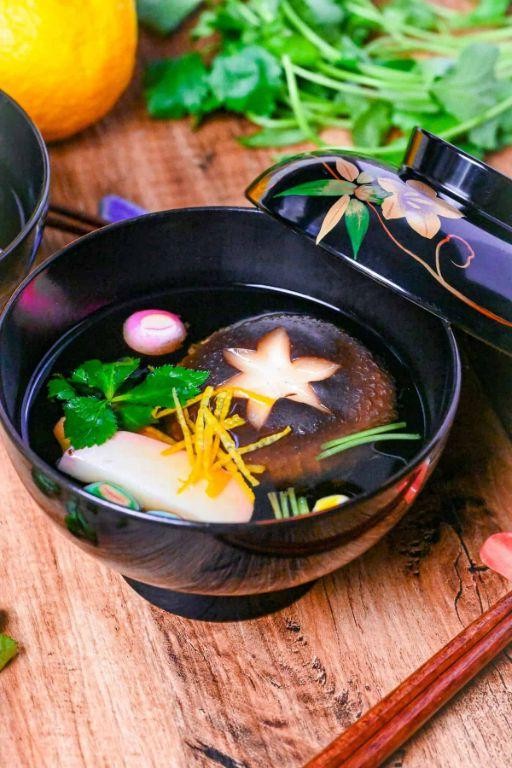
Venturing into the delicate flavors of Japanese cuisine, this Osuimono recipe offers a clear, comforting broth with earthy mushrooms. Perfect for a light meal or starter, it’s simplicity at its best.
Ingredients
- 4 cups dashi stock (homemade or instant)
- 1 cup shiitake mushrooms, thinly sliced (stems removed for less bitterness)
- 1 tbsp soy sauce (use usukuchi for a lighter color)
- 1 tsp salt (adjust to taste)
- 1 green onion, finely chopped (for garnish)
Instructions
- Heat the dashi stock in a medium pot over medium heat until it reaches a gentle simmer, about 5 minutes.
- Add the sliced shiitake mushrooms to the pot. Simmer for 3 minutes, or until the mushrooms are tender.
- Stir in the soy sauce and salt. Taste and adjust seasoning if necessary.
- Remove the pot from heat. Ladle the broth into bowls, ensuring each has an equal amount of mushrooms.
- Garnish with chopped green onion before serving.
Light and aromatic, this Osuimono boasts a clean taste with the umami richness of mushrooms. Serve it alongside sushi for a traditional Japanese meal experience.
Nabeyaki Udon (Hot Pot Udon Soup)
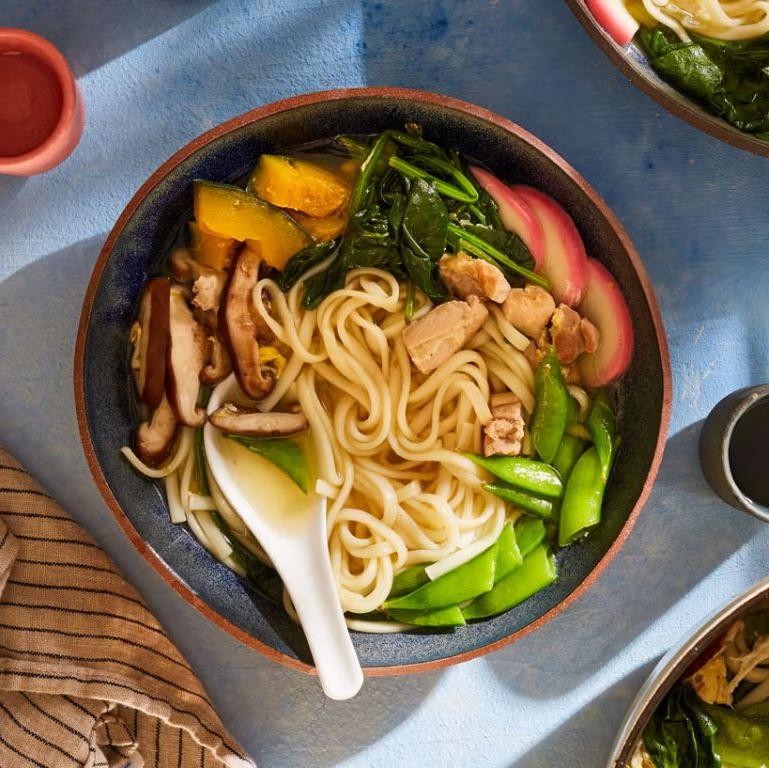
Venture into the comforting warmth of Nabeyaki Udon, a hearty hot pot udon soup that’s perfect for any season. This dish combines chewy udon noodles with a savory broth, topped with an array of fresh ingredients.
Ingredients
- 4 cups dashi stock (homemade or instant)
- 2 tbsp soy sauce (adjust to taste)
- 1 tbsp mirin
- 1 tsp sugar
- 2 servings udon noodles (fresh or frozen)
- 1 chicken thigh, sliced (skin-on for more flavor)
- 1 egg
- 2 shiitake mushrooms, sliced
- 1 green onion, chopped
- 1 sheet nori, torn into pieces (for garnish)
Instructions
- In a pot, heat the dashi stock over medium heat until it simmers.
- Add soy sauce, mirin, and sugar to the stock. Stir to dissolve the sugar.
- Add the chicken thigh slices to the pot. Cook for 5 minutes or until the chicken is no longer pink.
- While the chicken cooks, prepare the udon noodles according to package instructions. Drain and set aside.
- Add the udon noodles to the pot. Let them simmer in the broth for 2 minutes to absorb flavors.
- Crack the egg into the pot. Cover and cook for 3 minutes for a soft yolk.
- Add the shiitake mushrooms and green onion. Simmer for another 2 minutes.
- Divide the soup between two bowls. Garnish with nori pieces before serving.
Delight in the rich, umami-packed broth that hugs each noodle. The soft egg yolk adds a creamy texture, while the nori brings a subtle crunch. Serve with a side of pickled ginger for an extra zing.
Shoyu Ramen with Chashu Pork
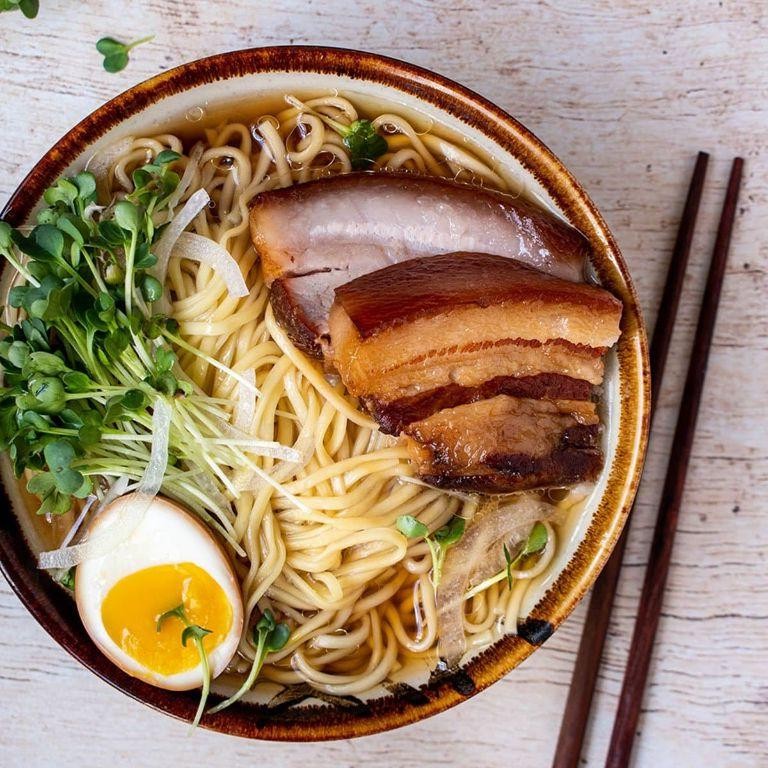
Kickstart your culinary adventure with this Shoyu Ramen with Chashu Pork, a dish that balances rich flavors and comforting warmth in every bite. Perfect for those seeking a homemade ramen experience without the fuss.
Ingredients
- 2 cups chicken broth (low sodium for better control)
- 1 tbsp soy sauce (adjust to taste)
- 1 tsp mirin (or a pinch of sugar as substitute)
- 2 cloves garlic, minced (fresh preferred)
- 1 inch ginger, sliced (peel for smoother texture)
- 1 ramen noodle bundle (fresh or dried)
- 1 soft-boiled egg (6 minutes for perfect runny yolk)
- 2 slices chashu pork (store-bought or homemade)
- 1 green onion, sliced (for garnish)
- 1 tsp sesame oil (or any neutral oil)
Instructions
- Heat chicken broth in a pot over medium heat until simmering, about 5 minutes.
- Add soy sauce, mirin, garlic, and ginger to the broth. Simmer for 10 minutes to infuse flavors.
- Cook ramen noodles according to package instructions, usually 3-4 minutes. Drain and set aside.
- While noodles cook, warm chashu pork slices in a pan over low heat, 1-2 minutes per side.
- Peel the soft-boiled egg and slice in half lengthwise for serving.
- Divide cooked noodles between two bowls. Pour hot broth over noodles.
- Top each bowl with chashu pork, half of the soft-boiled egg, and sliced green onions.
- Drizzle with sesame oil before serving for an aromatic finish.
Finally, savor the harmonious blend of savory broth, tender noodles, and succulent chashu pork. The soft-boiled egg adds a creamy texture, while the green onions bring a fresh crunch. Try serving with a side of pickled ginger for an extra zing.
Kitsune Udon (Udon with Fried Tofu)
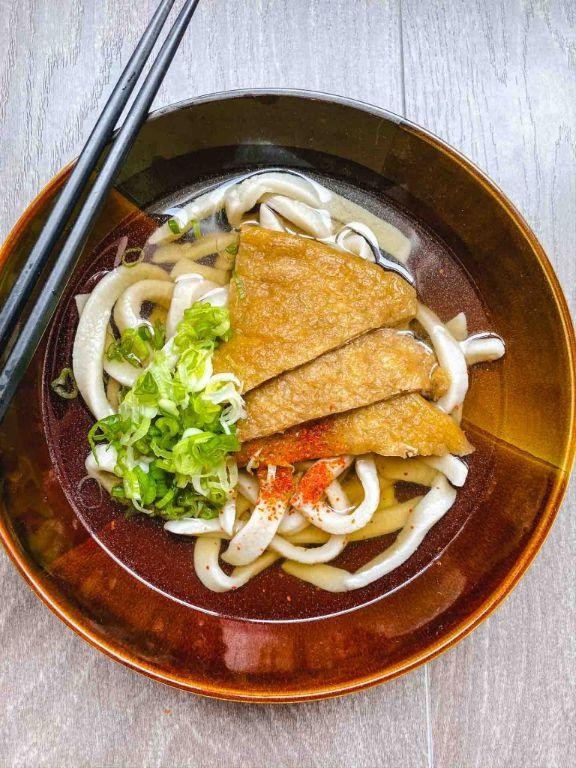
Craving a comforting bowl of udon? Kitsune Udon combines chewy noodles with sweet fried tofu for a simple yet satisfying meal.
Ingredients
- 2 packs of udon noodles (fresh or frozen, follow package instructions for cooking)
- 4 pieces of aburaage (fried tofu pockets, pre-sliced or whole)
- 4 cups dashi stock (homemade or instant, adjust strength to preference)
- 2 tbsp soy sauce (use usukuchi for a lighter color)
- 1 tbsp mirin (adds a subtle sweetness)
- 1 tsp sugar (balances the flavors)
- 2 green onions (thinly sliced, for garnish)
- Shichimi togarashi (optional, for a spicy kick)
Instructions
- Heat a pan over medium heat and add the aburaage. Cook for 1-2 minutes on each side until lightly browned. Set aside.
- In a pot, combine dashi stock, soy sauce, mirin, and sugar. Bring to a simmer over medium heat, then lower to keep warm.
- Cook udon noodles according to package directions. Drain and rinse under cold water to stop cooking.
- Divide noodles into bowls. Pour hot broth over the noodles.
- Top each bowl with two pieces of aburaage and garnish with green onions.
- Serve immediately, with shichimi togarashi on the side for those who like it spicy.
Notably, the aburaage soaks up the broth, becoming wonderfully juicy. The udon stays perfectly chewy, making every bite a delight. Try adding a soft-boiled egg for extra richness.
Tempura Udon (Udon with Tempura)
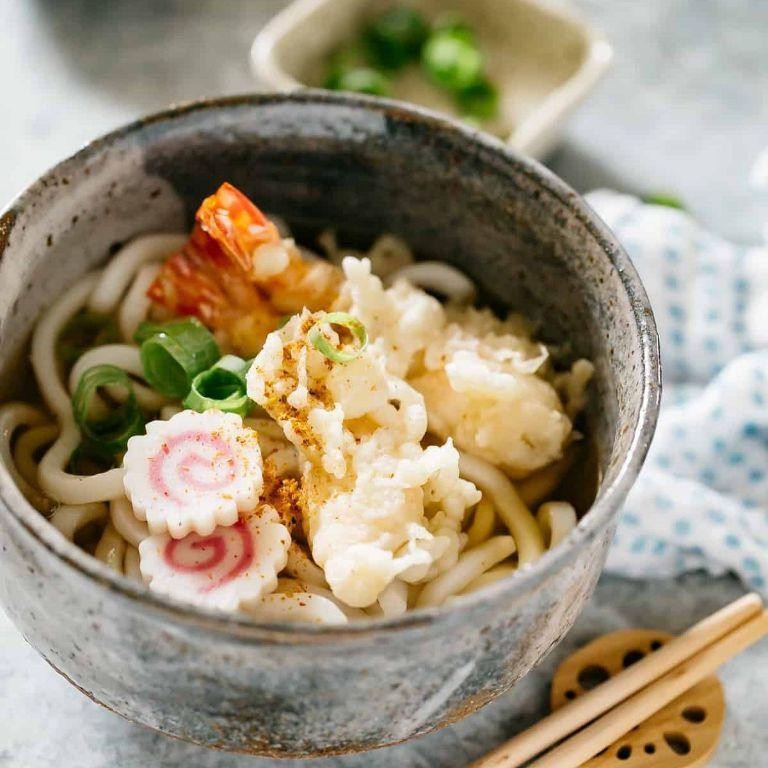
Just when you need a comforting bowl, Tempura Udon delivers with its crispy tempura and chewy noodles. This dish is a perfect blend of textures and flavors, ready in under 30 minutes.
Ingredients
- 2 cups udon noodles (fresh or frozen, cook as per package instructions)
- 1 cup tempura batter mix (use ice-cold water for extra crispiness)
- 1 cup assorted vegetables (sliced bell peppers, sweet potatoes, or zucchini work well)
- 4 cups dashi stock (homemade or instant, adjust salt to taste)
- 2 tbsp soy sauce (low sodium preferred)
- 1 tbsp mirin (adds a subtle sweetness)
- 1 tsp sugar (balances the flavors)
- Oil for frying (vegetable or canola, enough to deep fry)
- 2 green onions (thinly sliced for garnish)
Instructions
- Heat dashi stock in a pot over medium heat until simmering. Add soy sauce, mirin, and sugar. Stir to dissolve. Keep warm.
- Prepare tempura batter by mixing tempura mix with ice-cold water until just combined. Lumps are okay.
- Heat oil in a deep fryer or pot to 350°F. Dip vegetables in batter, let excess drip off, then fry until golden, about 2-3 minutes. Drain on paper towels.
- Cook udon noodles as per package instructions. Drain and rinse under cold water to stop cooking.
- Divide noodles among bowls. Pour hot broth over noodles. Top with tempura and garnish with green onions.
Light and crispy tempura contrasts beautifully with the soft udon and savory broth. For an extra kick, serve with a side of tempura dipping sauce or sprinkle with shichimi togarashi.
Chankonabe (Sumo Wrestler’s Hot Pot)
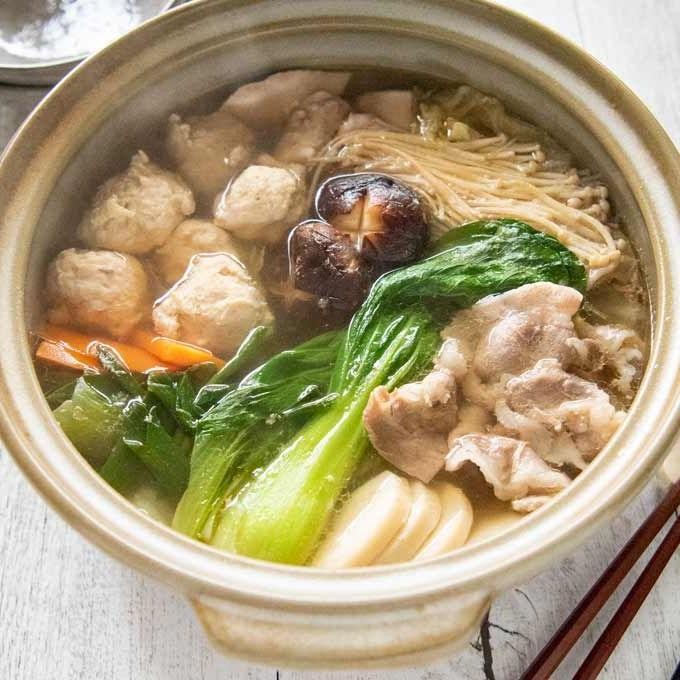
Every sumo wrestler’s secret to bulk up, this hearty hot pot is packed with protein and veggies. Easy to customize with your favorite ingredients.
Ingredients
- 1 lb chicken thighs, boneless and skinless (cut into bite-sized pieces)
- 4 cups chicken stock (homemade or low-sodium)
- 1 tbsp soy sauce (adjust to taste)
- 1 tbsp mirin (or substitute with a pinch of sugar)
- 1 tbsp sake (optional, for depth of flavor)
- 1/2 head napa cabbage (roughly chopped)
- 1 bunch green onions (cut into 2-inch pieces)
- 1 block firm tofu (cut into 1-inch cubes)
- 1 carrot (sliced into thin rounds)
- 4 shiitake mushrooms (stemmed and halved)
- 2 eggs (beaten, for optional addition)
Instructions
- In a large pot, bring chicken stock to a boil over medium-high heat.
- Add chicken pieces, soy sauce, mirin, and sake. Simmer for 10 minutes until chicken is cooked through.
- Layer napa cabbage, green onions, tofu, carrot, and shiitake mushrooms on top. Do not stir.
- Cover and simmer for 15 minutes until vegetables are tender.
- Optional: Drizzle beaten eggs over the top. Cover and cook for 2 more minutes until eggs are set.
- Serve hot directly from the pot. Tip: Use a slotted spoon to ensure each bowl gets a bit of everything.
Makes a comforting meal with tender chicken, silky tofu, and crisp-tender veggies. Perfect for sharing on a chilly evening.
Sukiyaki (Japanese Hot Pot with Thinly Sliced Beef)
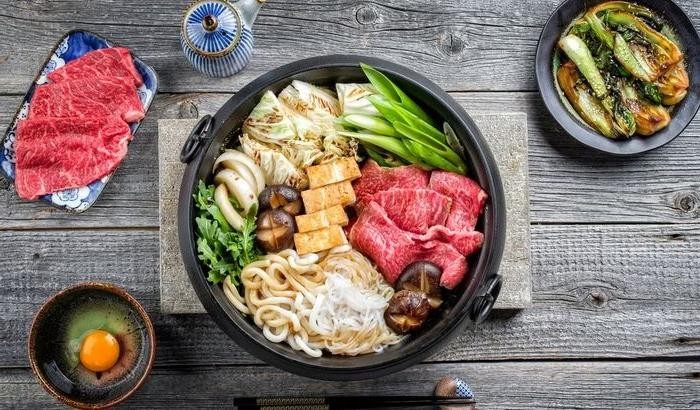
Get ready to warm up with Sukiyaki, a comforting Japanese hot pot that’s perfect for sharing. Gather around the table and cook thinly sliced beef and vegetables in a sweet-savory broth right at the table.
Ingredients
- 1 lb thinly sliced beef (chuck or ribeye works best)
- 1 cup soy sauce (use low-sodium if preferred)
- 1 cup mirin (or substitute with 3/4 cup sake plus 1/4 cup sugar)
- 1/2 cup sugar (adjust to taste)
- 1 cup dashi stock (or water in a pinch)
- 1 onion, thinly sliced
- 1 bunch green onions, cut into 2-inch pieces
- 1 package shirataki noodles, rinsed and drained (optional)
- 1 block firm tofu, cut into cubes
- 4 shiitake mushrooms, stems removed
- 1 bunch enoki mushrooms, roots trimmed
- 1 small napa cabbage, cut into bite-sized pieces
- 4 eggs (for dipping, optional)
Instructions
- In a large pot, combine soy sauce, mirin, sugar, and dashi stock. Bring to a simmer over medium heat, stirring until sugar dissolves.
- Add onion and green onions to the pot. Simmer for 2 minutes until slightly softened.
- Arrange beef slices, shirataki noodles, tofu, shiitake mushrooms, enoki mushrooms, and napa cabbage in the pot. Tip: Layer ingredients neatly for even cooking.
- Cover and simmer for 5 minutes. Tip: Do not stir too much to keep ingredients intact.
- Uncover and cook for another 3 minutes until beef is no longer pink and vegetables are tender. Tip: Skim off any foam for a clearer broth.
- Serve hot, with raw eggs on the side for dipping if desired.
Authentic Sukiyaki boasts tender beef and crisp-tender vegetables in a rich, slightly sweet broth. Try serving it with a side of steamed rice to soak up the delicious flavors.
Yosenabe (Seafood and Vegetable Hot Pot)

Craving a comforting yet healthy meal? Yosenabe, a Japanese hot pot, combines fresh seafood and vegetables in a light, flavorful broth.
Ingredients
- 4 cups dashi stock (homemade or instant)
- 1 tbsp soy sauce (adjust to taste)
- 1 tbsp mirin
- 1/2 lb white fish fillets, cut into chunks (cod or snapper work well)
- 1/2 lb shrimp, peeled and deveined
- 1/2 lb scallops
- 4 cups napa cabbage, chopped
- 1 cup carrots, sliced (thin for quick cooking)
- 1 cup shiitake mushrooms, stems removed
- 2 green onions, sliced (for garnish)
Instructions
- In a large pot, bring dashi stock to a simmer over medium heat.
- Add soy sauce and mirin to the stock, stirring to combine.
- Layer napa cabbage and carrots at the bottom of the pot to create a vegetable base.
- Arrange fish, shrimp, and scallops on top of the vegetables.
- Add shiitake mushrooms around the seafood.
- Cover the pot and simmer for 10 minutes, or until seafood is cooked through.
- Garnish with green onions before serving.
Rich in umami, the broth absorbs the essence of seafood and vegetables. Serve immediately with a side of steamed rice for a complete meal.
Oden (Japanese Fish Cake Stew)
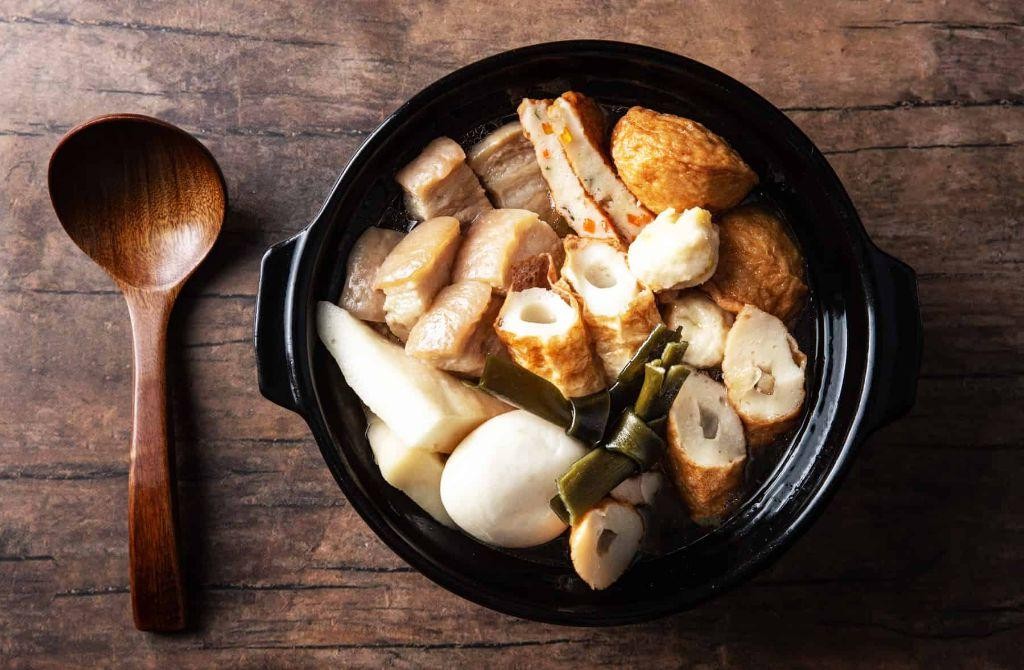
Nothing warms you up like a bowl of Oden, a comforting Japanese fish cake stew perfect for chilly evenings. Simple to make, it’s a hearty dish with deep umami flavors.
Ingredients
- 4 cups dashi stock (homemade or instant)
- 1/2 cup soy sauce (adjust to taste)
- 2 tbsp mirin
- 1 tbsp sugar
- Assorted fish cakes (about 1 lb, sliced)
- 2 boiled eggs (peeled)
- 1 daikon radish (peeled and cut into 1-inch rounds)
- 2 konnyaku (cut into triangles, optional)
Instructions
- In a large pot, combine dashi stock, soy sauce, mirin, and sugar. Bring to a boil over medium heat.
- Add daikon radish rounds to the pot. Simmer for 20 minutes until slightly tender.
- Gently add the fish cakes, boiled eggs, and konnyaku to the pot. Reduce heat to low.
- Simmer everything together for another 15 minutes. Skim off any foam that rises to the surface.
- Turn off the heat and let the stew sit for 10 minutes to allow flavors to meld.
Carefully ladle the stew into bowls, ensuring each serving gets a bit of everything. The daikon should be melt-in-your-mouth tender, while the fish cakes add a delightful chew. Serve with a side of karashi mustard for an extra kick.
Zosui (Japanese Rice Soup)

Filling and comforting, Zosui is a Japanese rice soup perfect for using leftover rice. It’s versatile, allowing for various toppings based on what you have on hand.
Ingredients
– 2 cups cooked white rice (day-old rice works best)
– 4 cups chicken broth (or vegetable broth for a vegetarian version)
– 1 tbsp soy sauce (adjust to taste)
– 1 tsp grated ginger (fresh for best flavor)
– 1 egg, beaten (optional for richness)
– 2 green onions, thinly sliced (for garnish)
– 1/2 cup diced cooked chicken (or tofu for vegetarian)
Instructions
1. Heat the chicken broth in a medium pot over medium heat until simmering.
2. Add the cooked white rice to the simmering broth, stirring to break up any clumps.
3. Stir in the soy sauce and grated ginger, adjusting the seasoning to your preference.
4. For a richer soup, slowly pour in the beaten egg while stirring the soup to create ribbons.
5. Add the diced cooked chicken or tofu, heating through for about 2 minutes.
6. Garnish with sliced green onions before serving.
7. Tip: For a thicker soup, let it simmer for an additional 5 minutes.
8. Tip: Add a splash of mirin for a subtle sweetness if desired.
9. Tip: Serve immediately to enjoy the best texture and warmth.
Rich in flavor and comforting in texture, Zosui is a delightful way to repurpose leftover rice. Its simplicity allows the subtle flavors of ginger and soy to shine, making it a versatile dish for any meal.
Tamago Kake Gohan (Egg Drop Rice Soup)
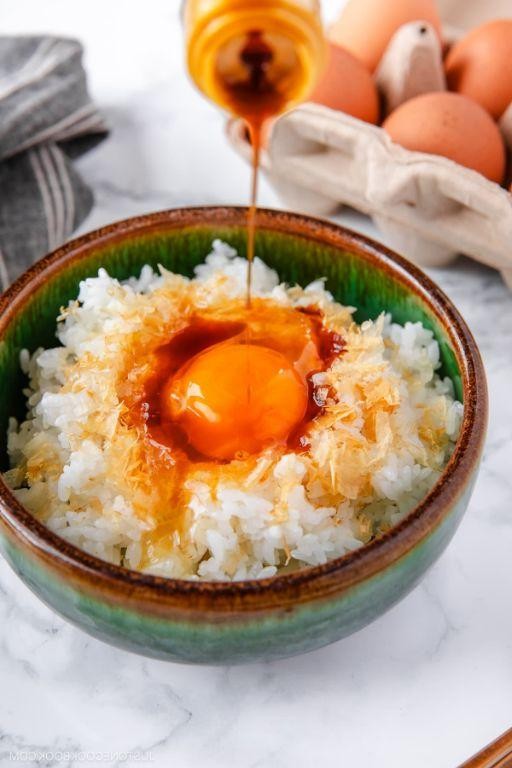
Venture into the simplicity of Japanese comfort food with this quick, nourishing dish. Perfect for busy mornings or a light meal, it’s a staple that’s both versatile and satisfying.
Ingredients
- 1 cup cooked short-grain rice (freshly cooked for best texture)
- 1 large egg (preferably at room temperature)
- 1 tbsp soy sauce (adjust to taste)
- 1/2 tsp mirin (optional, for a slight sweetness)
- 1 green onion, thinly sliced (for garnish)
- 1/4 tsp toasted sesame seeds (optional, for crunch)
Instructions
- Place the cooked rice in a bowl while still hot.
- Crack the egg directly over the rice. Tip: For a creamier texture, separate the yolk and add it first, then the white.
- Drizzle soy sauce and mirin over the egg and rice. Tip: Start with less soy sauce; you can always add more.
- Quickly mix everything together until the egg is partially cooked by the heat of the rice. Tip: The residual heat will gently cook the egg, creating a silky texture.
- Garnish with green onion and sesame seeds before serving.
Light and comforting, the dish offers a creamy texture with the richness of egg balanced by the umami of soy sauce. Try topping with a sprinkle of furikake or a dab of wasabi for an extra kick.
Gyuniku no Negimaki Soup (Beef and Scallion Roll Soup)

Mouthwatering and comforting, this Gyuniku no Negimaki Soup combines tender beef and fresh scallions in a savory broth. Perfect for a quick yet satisfying meal.
Ingredients
- 1 lb thinly sliced beef (sirloin or ribeye works best)
- 4 scallions, cut into 2-inch pieces (use both green and white parts)
- 4 cups beef broth (low sodium preferred)
- 1 tbsp soy sauce (adjust to taste)
- 1 tbsp mirin (or substitute with a pinch of sugar)
- 1 tsp sesame oil (for flavor enhancement)
- Salt and pepper (to season)
Instructions
- Lay the beef slices flat on a cutting board. Season lightly with salt and pepper.
- Place 2-3 pieces of scallion at the end of each beef slice. Roll tightly and secure with a toothpick if necessary.
- Heat a large pot over medium heat. Add the beef rolls and sear until browned, about 2 minutes per side. Remove and set aside.
- In the same pot, pour in the beef broth, soy sauce, and mirin. Bring to a simmer over medium heat.
- Return the beef rolls to the pot. Simmer gently for 5-7 minutes, until the beef is cooked through.
- Drizzle with sesame oil before serving. Remove toothpicks if used.
Comforting and rich, the soup boasts a perfect balance of savory and sweet. Serve with a side of steamed rice for a complete meal.
Kabocha no Soup (Japanese Pumpkin Soup)

You’ll love the creamy, comforting embrace of Kabocha no Soup, a Japanese pumpkin soup that’s as nutritious as it is delicious. Its sweet, earthy flavor pairs perfectly with a hint of spice.
Ingredients
- 1 small Kabocha squash (about 2 lbs), seeded and cubed
- 1 tbsp olive oil (or any neutral oil)
- 1 medium onion, diced
- 2 cloves garlic, minced
- 4 cups vegetable broth (adjust for desired thickness)
- 1/2 cup heavy cream (sub coconut milk for vegan)
- 1/2 tsp salt (adjust to taste)
- 1/4 tsp black pepper (adjust to taste)
- 1/4 tsp nutmeg (optional for warmth)
Instructions
- Preheat a large pot over medium heat. Add olive oil.
- Saute onion until translucent, about 5 minutes. Stir occasionally.
- Add garlic. Cook for 1 minute until fragrant.
- Add Kabocha squash. Stir to combine with onions and garlic.
- Pour in vegetable broth. Bring to a boil.
- Reduce heat to low. Simmer until squash is tender, about 20 minutes.
- Remove from heat. Blend soup until smooth using an immersion blender.
- Stir in heavy cream, salt, pepper, and nutmeg. Heat through for 2 minutes.
- Adjust seasoning if needed. Serve hot.
Great for chilly evenings, this soup’s velvety texture and rich flavor shine. Garnish with roasted pumpkin seeds or a drizzle of cream for an elegant touch.
Shiitake to Tofu no Soup (Shiitake Mushroom and Tofu Soup)

Perfect for a light yet satisfying meal, this Shiitake Mushroom and Tofu Soup combines earthy flavors with a silky texture. Packed with protein and umami, it’s a quick fix for any day.
Ingredients
- 4 cups vegetable broth (low sodium preferred)
- 1 tbsp sesame oil (or any neutral oil)
- 2 cloves garlic, minced (fresh is best)
- 1 inch ginger, grated (peel first)
- 8 oz shiitake mushrooms, sliced (stems removed)
- 14 oz firm tofu, cubed (pat dry before use)
- 2 tbsp soy sauce (adjust to taste)
- 1 tsp rice vinegar
- 2 green onions, sliced (for garnish)
Instructions
- Heat sesame oil in a pot over medium heat until shimmering, about 1 minute.
- Add minced garlic and grated ginger. Sauté until fragrant, 30 seconds.
- Add sliced shiitake mushrooms. Cook until they release moisture and soften, 5 minutes.
- Pour in vegetable broth. Bring to a boil, then reduce to a simmer for 10 minutes.
- Gently add cubed tofu. Simmer for another 5 minutes to heat through.
- Stir in soy sauce and rice vinegar. Taste and adjust seasoning if needed.
- Ladle into bowls. Garnish with sliced green onions before serving.
Silky tofu and tender mushrooms make each spoonful a delight. Serve with a side of steamed rice for a fuller meal.
Conclusion
Japanese soups offer a comforting bowl for every season, blending tradition with taste. Just as the recipes vary from the light and refreshing to the rich and hearty, there’s a perfect match for every palate and occasion. We invite you to explore these 19 delicious options, share your favorites in the comments, and spread the warmth by pinning this article on Pinterest. Happy cooking!


